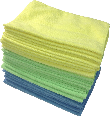Anything from a spilled glass of water to a severe flooding disaster threatens your books. The following process can be modified to fit your particular situation, whether it is ten sopping books or just ten damp pages.
The first response you can take for wet books is wrapping them in plastic and putting them in the freezer. This is especially useful if you don't have time to immediately dry out the book or if you have multiple wet books that you want to save but simply can't handle all at once. Freezing stops the water from spreading and prevents mold from growing. If possible, allow as much water to drain from the book as you can before freezing.
To get water to drain from a sopping book stand it on its head or tail and place strong, durable paper towels inside the covers. Don't try to separate the pages yet, they will be too wet and more likely to tear. Change the paper towels as they become wet. You can also put a towel or draining board under the book so that the water will have somewhere to go.
Once the excess water has drained and the book is just wet, place paper towels between the leaves. Placing a paper towel every twenty pages or so should be sufficient. Change the towels as they become wet. On average, this should be every half hour.
When the book is just damp and the pages are more durable, fan the pages out and allow air to circulate around and in the book. This can be done with a fan or hair dryer, or by placing the book by an open window with a stiff breeze. Don't allow the book to dry completely like this, otherwise the pages will be warped.
Before the pages are completely dry, close the book. Keep paper towels inside the covers. Book covers are made of heavier material and will take longer to dry. Once you have closed the book, lay it on its side and put a small weight on top. This should flatten the pages as much as possible.
For books that just get wet or damp, use the relevant steps from this process to dry the books out. If just a portion of a book gets wet, separate the wet portion from the dry using paper towels and then perform the needed steps from the drying process.
Pay special attention to the binding of your book, making sure that it dries out completely. If there is still dampness in the binding, it could result in mold.

The Power of Microfiber! Zwipes Microfiber Cleaning Cloths will become your favorite tool for every cleaning task. This 36-cloth package is perfect for hundreds of uses in the garage, kitchen, bathroom, laundry, and all around the house. Each cloth is tough, streak-free, lint-free, reusable, and washable. Check out Microfiber Cleaning Cloths today!
These useful tips can help you to keep all of your books clean and inviting for everyone in the family. Dust, mold, ...
Discover MoreFREE SERVICE: Get tips like this every week in Cleaning Tips from Tips.Net. Enter your address and click "Subscribe."
2022-02-21 00:42:08
april
:-magazine got wet & dried could you submerged it all again & work getting it dry out
FREE SERVICE: Get tips like this every week in Cleaning Tips from Tips.Net. Enter your address and click "Subscribe."
Copyright © 2025 Sharon Parq Associates, Inc.
Comments